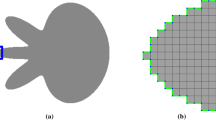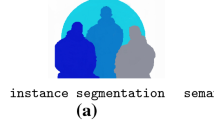Abstract
We propose a variational framework for determining global minimizers of rough energy functionals used in image segmentation. Segmentation is achieved by minimizing an energy model, which is comprised of two parts: the first part is the interaction between the observed data and the model, the second is a regularity term. The optimal boundaries are the curves that globally minimize the energy functional. Our motivation comes from the observation that energy functionals are traditionally complex, for which it is usually difficult to precise global minimizers corresponding to “best” segmentations. Therefore, we focus on basic energy models, which global minimizers can be characterized. None of the proposed segmentation models captures all the important scene variables but may be useful to get an insight into objects, surfaces or parts of objects in the scene. In this paper, we prove that the set of curves that minimizes the cost functionals is a subset of level lines, i.e. the boundaries of level sets of the image. For the completeness of the paper, we present a fast algorithm for computing partitions with connected components. It leads to a sound initialization-free algorithm without any hidden parameter to be tuned. We illustrate the performance of our algorithm with several examples on both 2D biomedical and aerial images, and synthetic images.
Similar content being viewed by others
References
S.T. Acton and D.P. Mukherjee, “Scale space classification using area morphology,” IEEE Trans. Image Processing, Vol. 9, No. 4, pp. 623–635, 2000.
L. Alvarez, Y. Gousseau, and J.M. Morel, “cales in natural images and a consequence on their bounded variation,” in Int. Conf. on Scale-Space Theories Comp. Vis., Kerkyra, Greece, Sept. 1999, pp. 247–258.
O. Amadieu, E. Debreuve, M. Barlaud, and G. Aubert, “Simultaneous inward and outward curve evolution,” in Int. Conf. on Image Processing, Kobe, Japan, 1999.
J. Beaulieu and M. Goldberg, “Hierarchy in picture segmentation: Astepwise optimization approach,” IEEE Trans. Patt. Anal. and Mach. Int., Vol. 11, No. 2, pp. 150–163, 1989.
A. Blake and A. Zisserman, Visual Reconstruction, MIT Press: Cambridge, Mass, 1987.
V. Caselles, B. Coll, and J.M. Morel, “Topographic maps and local contrast changes in natural images,” Int. J. Computer Vision, Vol. 33, No. 1, pp. 5–27, 1999.
V. Caselles, R. Kimmel, and G. Sapiro, “Geodesic active contours,” Int. J. Computer Vision, Vol. 22, No. 1, pp. 61–79, 1997.
T. Chan and L. Vese, “Active contour model without edges,” in Int. Conf. on Scale-Space Theories Comp. Vis., Kerkyra, Greece, Sept. 1999, pp. 141–151.
C. Chang, K. Chen, J. Wang, and M. Althouse, “A relative entropy-based approach to image processing,” Pattern Recognition, Vol. 27, No. 9, pp. 1275–1289, 1994.
C. Chesnaud, P. Réfrégier, and V. Boulet, “Statistical region snake-based segmentation adapted to different physical models,” IEEE Trans. Patt. Anal. and Mach. Int., Vol. 21, No. 11, pp. 1145–1157, 2000.
L.D. Cohen. “On active contour models and balloons,” CVGIP: Image Understanding, Vol. 53, No. 2, pp. 211–218, 1991.
L.D. Cohen, “Deformable curves and surfaces in image analysis,” in Int. Conf. Curves and Surfaces, Chamonix, France, July 1996.
T. Darrell and A. Pentland, “Cooperative robust estimation using layers of support,” IEEE Trans. Patt. Anal. and Mach. Int., Vol. 17, No. 5, pp. 474–487, 1995.
X. Descombes and F. Kruggel, “A markov pixon information approach for low-level image description,” IEEE Trans. Patt. Anal. and Mach. Int., Vol. 21, No. 6, pp. 482–494, 1999.
A. Desolneux, L. Moisan, and J.M. Morel, Maximal Meaningful Events and Applications to Image Analysis, preprint of CMLA, Cachan, France, 2000.
M.A.T. Figueiredo, J.M.N. Leitao, and A.K. Jain, “Unsupervised contour representation and estimation using b-plines and mininim description length criterion,” IEEE Trans. Image Processing, Vol. 6, No. 9, pp. 1075–1087, 2000.
J. Froment, “Perceptible level lines and isoperimetric ratio,” in Int. Conf. on Image Processing, Vancouver, Canada, 2000.
S. Geman and D. Geman, “Stochastic relaxation, gibbs distributions, and the bayesian restoration of images,” IEEE Trans. Patt. Anal. and Mach. Int., Vol. 6, No. 6, pp. 721–741, 1984.
U. Grenander and M.I. Miller, “Representations of knowledge in complex systems,” J. Royal Statistical Society, Series B, Vol. 56, No. 4, pp. 549–603, April 1994.
J. Istas, Statistics of Processes and Signal-Image Segmentation, University of Paris VII, 1997.
I.H. Jermyn and H. Ishikawa, “Globally optimal regions and boundaries,” in Int. Conf. on Comp. Vis., Kerkyra, Greece, Sept. 1999, pp. 904–910.
J.N. Kapur, P.K. Sahoo, and A.K.C. Wong, “A new method for gray-level picture thresholding using the entropy of the histogram,” Comp. Vis. Graphics and Image Proc., Vol. 29, pp. 273–285, 1985.
M. Kass, A. Witkin, and D. Terzopoulos, “Snakes: Active contour models,” Int J. Computer Vision, Vol. 12, No. 1, pp. 321–331, 1987.
C. Kervrann and F. Heitz, “A hierarchical markov modeling approach for the segmentation and tracking of deformable shapes,” Graphical Models and Image Processing, Vol. 60, No. 3, pp. 173–195, 1998.
S. Kichenesamy, A. Kumar, P. Olver, and A. Yezz, “Conformal curvature flows: From transition to active contours,” Archive for Rational Mechanics and Anal., Vol. 134, pp. 275–301, 1996.
G. Koepfler, C. Lopez, and J.M. Morel, “A multiscale algorithm for image segmentation by variational method,” SIAM J. Numerical Analysis, Vol. 31, No. 1, pp. 282–299, 1994.
Y.G. Leclerc, “Constructing simple stable descriptions for image partitioning,” Int. J. Computer Vision, Vol. 3, pp. 73–102, 1989.
L.M. Lorigo, O.D. Faugeras, W.E.L. Grimson, R. Keriven, and R. Kikinis, “Segmentation of bone in clinical knee mri using texture-based geodesic active contours,” in Int. Conf. Medical Image Computing and Computer-Assisted Intervention, Cambridge MA, USA, Oct. 1998, pp. 1195–1204.
G. Matheron, Random Sets and Integral Geometry, JohnWiley: New York, 1975.
T. McInerney and D. Terzopoulos, “T-snakes: Topology adaptive snakes,” Medical Image Analysis, Vol. 4, No. 2, pp. 123–1361, 2000.
J. Møller and R.P. Waagepertersen, “Markov connected component fields,” Adv. in Applied Probability, pp. 1–35, 1998.
P. Monasse and F. Guichard, “Fast computation of a contrastinvariant image representation,” IEEE Trans. Image Processing, Vol. 9, No. 5, pp. 860–872, 2000.
J.M. Morel and S. Solimini, Variational Methods in Image Segmentation, Birkhauser, 1994.
D. Mumford, “The bayesian rationale for energy functionals,” Geometry-Driven Diffusion in Computer Vision, Bart Romeny (Ed.), Kluwer Academic, 1994, pp. 141–153.
D. Mumford and J. Shah, “Optimal approximations by piecewise smooth functions and variational problems,” Communication on Pure and Applied Mathematics, Vol. 42, No. 5, pp. 577–685, 1989.
S. Osher and J. Sethian, “Fronts propagating with curvature dependent speed: Algorithms based on the hamilton-jacobi formulation,” J. Computational Physics, Vol. 79, pp. 12–49, 1988.
F. O'sullivan and M. Qian, “A regularized contrast statistic for object boundary estimation—Implementation and statistical evaluation,” IEEE Trans. Patt. Anal. and Mach. Int., Vol. 16, No. 6, pp. 561–570, 1994.
N. Paragios and R. Deriche, “Coupled geodesic active regions for image segmentation: A level set approach,” in Euro. Conf. on Comp. Vis., Vol. 2, Dublin, Ireland, June 2000, pp. 224–240.
T. Pavlidis and Y.T. Liow, “Integrating region growing and edge detection,” IEEE Trans. Patt. Anal. and Mach. Int., Vol. 12, pp. 225–233, 1990.
N. Rougon and F. Preteux, “Directional adaptive deformable models for segmentation,” J. Electronic Imaging, Vol. 7, No. 1, pp. 231–256, 1998.
P.K. Sahoo, C. Wilkins, and J. Yeager, “Threshold selection using Renyi's entropy,” Pattern Recognition,Vol. 30, No. 1, pp. 71–84, 1997.
P. Salembier and J. Serra, “Flat zones filtering, connected operators, and filters by reconstruction,” IEEE Trans. Image Processing, Vol. 4, No. 8, pp. 1153–1160, 1995.
C. Samson, L. Blanc-Féraud, G. Aubert, and J. Zerubia, “A level set model for image classification,” in Int. Conf. on Scale-Space Theories Comp. Vis., Kerkyra, Greece, Sept. 1999, pp. 306–317.
C. Schnörr, “A study of a convex variational diffusion approach for image segmentation and feature extraction,” J. Math. Imaging and Vision, Vol. 3, No. 8, pp. 271–292, 1998.
J. Sethian, Level Sets Methods: Evolving Interfaces in Geometry, Fluid Mechanics, Computer Vision, and Material Science, Cambridges University Press: Cambridge, 1996.
L. Vincent and P. Soille, “Watershed in digital spaces: An effi-cient algorithm based on immersion simulations,” IEEE Trans. Patt. Anal. and Mach. Int., Vol. 13, No. 6, pp. 583–598, 1991.
J.P. Wang, “Stochastic relaxation on partitions with connected components and its application to image segmentation,” IEEE Trans. Patt. Anal. and Mach. Int., Vol. 20, No. 6, pp. 619–636, 1998.
A. Yezzi, A. Tsai, and A. Willsky, “A statistical approach to snakes for bimodal and trimodal imagery,” in Int. Conf. on Comp. Vis., Kerkyra, Greece, Sept. 1999, pp. 898–903.
L. Younes, “Calibrating parameters of cost functionals,” in Euro. Conf. on Comp. Vis., Dublin, Ireland, June 2000.
S.C. Zhu and A. Yuille, “Region competition: Unifying snakes, region growing, and bayes/mdl for multiband image segmentation,” IEEE Trans. Patt. Anal. and Mach. Int., Vol. 18, No. 9, pp. 884–900, 1996.
Author information
Authors and Affiliations
Rights and permissions
About this article
Cite this article
Kervrann, C., Trubuil, A. Optimal Level Curves and Global Minimizers of Cost Functionals in Image Segmentation. Journal of Mathematical Imaging and Vision 17, 153–174 (2002). https://doi.org/10.1023/A:1020685520659
Issue Date:
DOI: https://doi.org/10.1023/A:1020685520659




